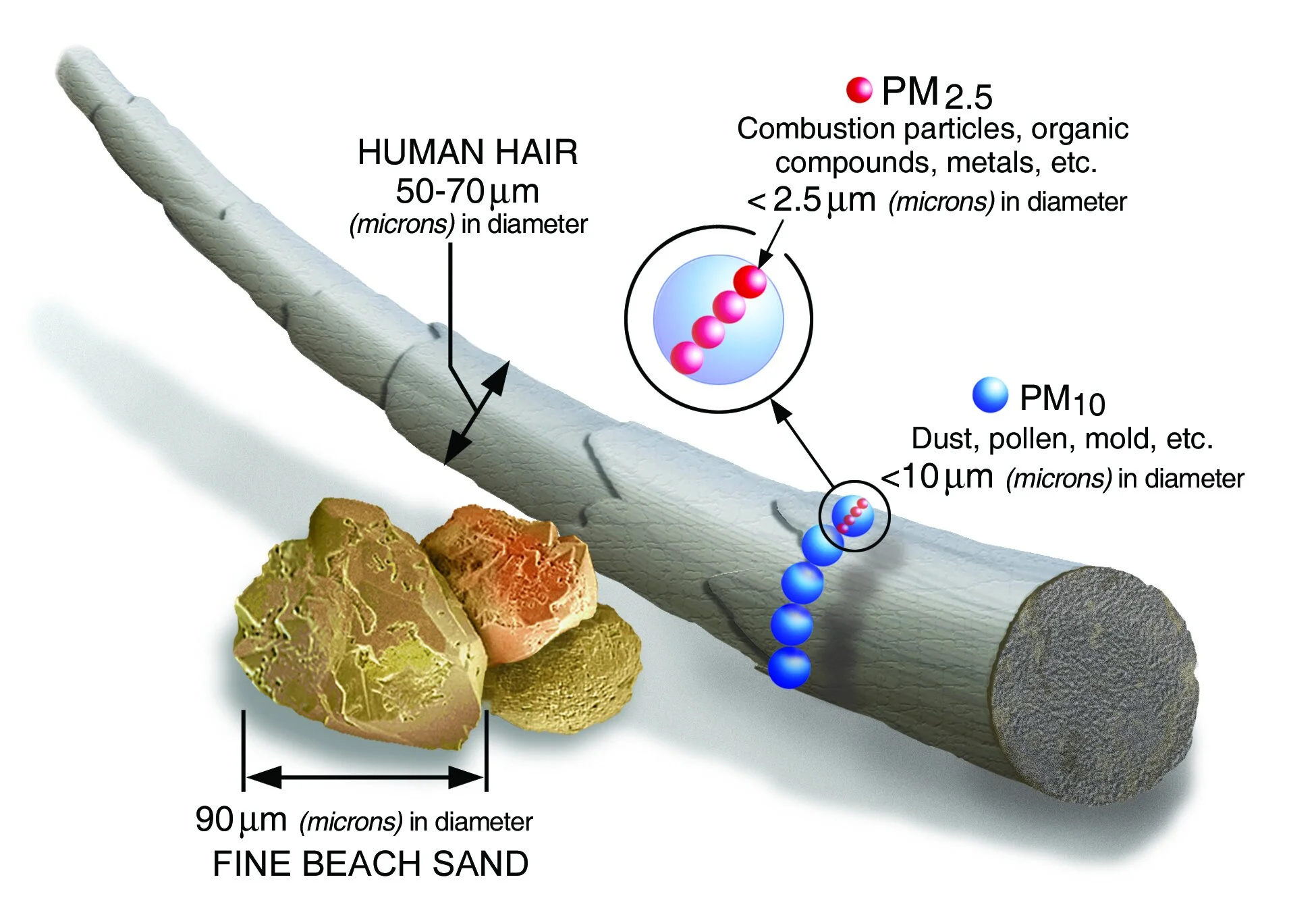In San Francisco, I previously worked for an energy utility provider on construction projects at electrical substations. During the early days one hundred years ago, the City used coal gasification to provide natural gas which left toxic poly-aromatic hydrocarbons (PNAs) in the ground. At one electrical substation, we needed to construct new upgrades so, especially due to an elementary school next door, monitoring and minimizing air pollution became paramount. I was in charge of the environmental site monitoring so made sure we kept the soils wet and stopped work during windy conditions to prevent blowing sand. I also set up air monitors to collect PM10 and PM2.5. As will be explained, particles much smaller than human hair are most dangerous getting deep into our lungs. At the construction site, our precautions and testing ensured we did not spread contamination.
As shown on the EPA diagram and text:
“PM stands for particulate matter (also called particle pollution): the term for a mixture of solid particles and liquid droplets found in the air. Some particles, such as dust, dirt, soot, or smoke, are large or dark enough to be seen with the naked eye. Others are so small they can only be detected using an electron microscope.
Particle pollution includes:
PM10 : inhalable particles, with diameters that are generally 10 micrometers and smaller; and
PM2.5 : fine inhalable particles, with diameters that are generally 2.5 micrometers and smaller.
How small is 2.5 micrometers? Think about a single hair from your head. The average human hair is about 70 micrometers in diameter – making it 30 times larger than the largest fine particle.
Sources of PM
These particles come in many sizes and shapes and can be made up of hundreds of different chemicals.
Some are emitted directly from a source, such as construction sites, unpaved roads, fields, smokestacks or fires.
Most particles form in the atmosphere as a result of complex reactions of chemicals such as sulfur dioxide and nitrogen oxides, which are pollutants emitted from power plants, industries and automobiles.
What are the Harmful Effects of PM?
Particulate matter contains microscopic solids or liquid droplets that are so small that they can be inhaled and cause serious health problems. Some particles less than 10 micrometers in diameter can get deep into your lungs and some may even get into your bloodstream. Of these, particles less than 2.5 micrometers in diameter, also known as fine particles or PM2.5, pose the greatest risk to health.”
What about Covid-19 Particle Size and Links to Air Pollution?
The Coronavirus particles are smaller than PM2.5 by an order of magnitude!
Here is a May 5th updated alert by Harvard University’s School of Public Health linking an increased risk of Covid-19 illness to air pollution:
“People with COVID-19 who live in U.S. regions with high levels of air pollution are more likely to die from the disease than people who live in less polluted areas, according to a new nationwide study from Harvard T.H. Chan School of Public Health….The study results underscore the importance of continuing to enforce existing air pollution regulations to protect human health both during and after the COVID-19 crisis.”
Comparing this finding with the current news may explain why New York is reporting 66% of the new hospitalizations are coming from people staying home; why the pandemic is affecting more Black and Hispanic people as they live in more polluted areas, and why it is so important to improve our scientific understanding of the pandemic and not cut existing environmental regulations before we are too quick to return to “normal.”
However, the Administration and industrialists appear to be suppressing news and challenging these results as well as the Center for Disease Control (CDC’s) guidelines for reopening the country which do not take into account the connection of air pollution and Covid-19 which the White House is shelving the CDC guidelines.
Here is a Washington Post article from yesterday:
“An early study from Harvard University linking dirty air to the worst coronavirus outcomes has quickly become a political football in Washington.
Presidential candidates, agency regulators, oil lobbyists and members of Congress from both parties are using the preliminary research to advance their own political priorities — well before it has a chance to be peer-reviewed.
The stakes are high because the study’s tentative findings could prove enormously consequential for both the pandemic's impact and the global debate over curbing air pollution. The researchers found that pollution emanating from everything from industrial smokestacks to household chimneys is making the worst pandemic in a century even more deadly.”
Here is a related article by The Guardian with an excerpt:
“The principal risk of catching Covid-19 is contact with an infected person, and the quality of healthcare is vital in determining the outcome. But air pollution may be important in three ways, studies show. Higher death rates due to lungs and hearts weakened by dirty air is the best understood. Pollutants also inflame lungs, potentially making catching the virus more likely and raising concern about rising pollution levels after lockdowns are lifted. Finally, particles of pollution might even help carry the virus further afield.”
As a practitioner of environmental science, as well as a believer in The Golden Rule and Law of Karma, I cannot help but see the need for us to reduce pollution worldwide. Do you agree this is a global environmental justice issue? Please share your comments below.

